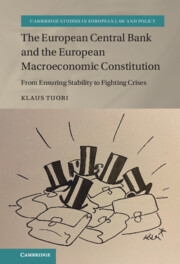 The European Central Bank and the European Macroeconomic Constitution
The European Central Bank and the European Macroeconomic Constitution Book contents
- The European Central Bank and the European Macroeconomic Constitution
- Cambridge Studies in European Law and Policy
- The European Central Bank and the European Macroeconomic Constitution
- Copyright page
- Contents
- Figures
- Series Editors’ Preface
- Preface and Acknowledgements
- Abbreviations
- 1 Introduction: A Supranational Central Bank as a Subject
- Part I The ECB as the Central Bank of the European Macroeconomic Constitution
- 2 The Three Foundations of the EMU
- 3 The Principles of the European Macroeconomic Constitution
- 4 ECB Organisation, Monetary Policy Strategy and Operational Framework
- Part II Crises, ECB Measures and the Macroeconomic Constitution
- Part III The ECB from a Central Bank of Stability to a Central Bank of Crisis
- Bibliography
- Index
4 - ECB Organisation, Monetary Policy Strategy and Operational Framework
from Part I - The ECB as the Central Bank of the European Macroeconomic Constitution
Published online by Cambridge University Press: 15 September 2022
- The European Central Bank and the European Macroeconomic Constitution
- Cambridge Studies in European Law and Policy
- The European Central Bank and the European Macroeconomic Constitution
- Copyright page
- Contents
- Figures
- Series Editors’ Preface
- Preface and Acknowledgements
- Abbreviations
- 1 Introduction: A Supranational Central Bank as a Subject
- Part I The ECB as the Central Bank of the European Macroeconomic Constitution
- 2 The Three Foundations of the EMU
- 3 The Principles of the European Macroeconomic Constitution
- 4 ECB Organisation, Monetary Policy Strategy and Operational Framework
- Part II Crises, ECB Measures and the Macroeconomic Constitution
- Part III The ECB from a Central Bank of Stability to a Central Bank of Crisis
- Bibliography
- Index
Summary
The chapter introduces and analyses the ECB as it was designed to become the central bank of the European Macroeconomic Constitution. It provides a view on how the ECB operates and how it aims to achieve price stability but also becomeaccountable. Three different but interlinked concepts are evaluated: monetary policy strategy, the monetary policy transmission mechanism, and the operational framework. Monetary policy strategy describes the ECB’s role in the economy and how it achieves its objectives. The monetary policy transmission mechanism is embedded in monetary policy strategy and seeks to explain how monetary policy measures are transmitted to the economy, and how monetary policy decisions affect the primary objective of price stability. The operational framework makes monetary policy decisions operational by proving the link from monetary policy decisions to money market interest rates and ultimately to the economy at large. These are discussed in turn after a brief description of the ECB’s organisation and decision-making bodies. A broad constitutional assessment of the ECB as it was designed finds that many elements raise some questions but generally the ECB confirmed the requirements of the European Macroeconomic Constitution, which is, in turn, a further confirmation of the constitutional reconstruction.
Keywords
- Type
- Chapter
- Information
- The European Central Bank and the European Macroeconomic ConstitutionFrom Ensuring Stability to Fighting Crises, pp. 92 - 126Publisher: Cambridge University PressPrint publication year: 2022
